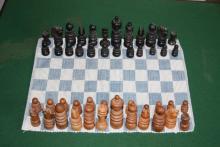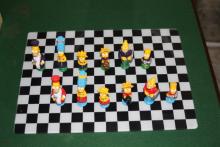General Advice for bishop endings
(1) The easiest endings to draw are those with opposite coloured bishops.(2) Do not place pawns on the colour of your bishop.
(3) BB vs. BN or NN are usually a real advantage.
In open positions the two bishops are murder: in most other
positions they are a real advantage.
[See Double Bishop Endings.]
(4) In open or semi-open positions a lone bishop is usually
superior to a lone knight.
The knight is superior to the bishop in blocked positions or when
the bishop is hemmed in by pawns on the same colour squares as the
bishop.
K+B vs. K+P
Normally the bishop can keep an eye on the P from far enough away to keep the draw in hand, even two Ps if the opposing K is not closeK+B+P vs. K
A simple win unless it's an a-/h-P when the lone K can blockade on the colour square opposite to the B. Similarly, K+B vs. K+B+gP+hP may be drawn for this reason if BxgP is allowed.K+B vs. K+B+P
Often a draw unless the P is far advanced. The side with the P must try to drive the B from covering the path of the P. This can usually be done only if the Bs travel on the same colour squares - bishops of opposite colours usually can set up immovable blockades or threats of sacrifice - and even then, only if the Pawn is not a central one and the defending K is not close.K+N vs. K+B+P
The bishop can try to create zugzwang positions when the N must move away, and although blockades are possible the ending is promising. K+N vs. K+B+gP+hP may be drawn for the reason noted above if NxgP is allowed.K+B vs. K+N+P
The N+P have far more difficulty winning against the B, but again on the wing the B may run out of squares and the K may be distant.Key ideas in bishop endings:
sacrifice to draw, running out of space at the edge, draw with a-/h-pawns, draw with opposite coloured bishops, controlling the diagonals leading to the queening square
space to dodge
|
With both Kings distant it's the same; with wKe8, Bke1 1.Bb4! wins (threat Be7) [thanks to Bart Robeyns for rescuing this example].
no space at the edge
|
draw with bishops of opposite colour
|
1 Kd6 Bg8, 2 Ke7 and if later Kf6, ...Bh7! when d5 is no threat.
controlling diagonals
|
1 Bf6 Kc2, 2 Be7 Be3 3 Bd6 Bg5, 4 Be5! and 5 Bf6
Studies
These comprise the selection given by John Littlewood in Chess Coaching. Littlewood also gives an ABC for Pawn, Knight, Rook and Queen endings.
|
W to play wins
The bishop is poorly placed. 1 c6! Be5; 2 b6
winning
|
W to play draws against best defence
Better bB position: 1 c6 Bd8! or 1 b6 Bd4! 2 b7
Be5
|
W to play draws
The wK is just close enough to hold. 1 Kc2! f4; 2 Kd1
f3; 3 Ke1, f2+; 4 Kf1, Kf3; 5 Bd4, g3; 6 Bxf2,
gxf2 stalemate or 2...g3; 3 Ke1, g2; 4 Bxf4+! draws
|
W to play wins
If Black can control e7 with the B, the pawn can never
advance without ...Bxe7 drawing. White must drive off the B:
1 Bf6+ Kc8; 2 Be7, Bf2; 3 Bd6, Bh4; 4 Be5 (1...Kc7; 2 Be7, Bf2; 3
Bd6+!)
|
B to play draws
The bK is closer to the pawn, and can nip round to prevent 6 Bf6:
1...Kd5! 2 Bf6, Ke4! 3 Be7, Bf2; 4 Ba3, Bh4; 5 Bb2, Kf5!
|
W to play wins
(check)
1 Kg8! controlling the 'short side' and threatening 2
Bf8, Be3; 3 Ba3, Bh6; 4 Bb2 and 5 Bg7,
so 1...Kf5, but 2 Bf8, Be3; 3 Ba3, Bh6; 4 Bc1!
|
W to play wins
(Centurini)
Take a deep breath...
If White's bishop were on a7, 1 Bb8, Bg1; 2 Bg3, Ba7; 3
Bf2! wins
But 1 Bh4, Kb6! 2 Bf2+ Ka6 and wB can't get to a7.
If the bB was on g3, 1 Bh4! Bh2; 2 Bf2 and 3 Ba7, 4 Bb8 wins.
It's not quite zugzwang, since with Black to move 1...Bd6!
2 Be7, Bh2 holds (3 Bc5 isn't possible here)
So, zugzwang would be on if one of the squares h2 or d6
were taken away from the bB.
1 Bh4, Kb5; 2 Bf2, Ka6; 3 Bf5! Bg3; 4 Be7, Kb5; 5 Bd8, Kc6; and now
6 Bh4! Bh2 when 7 Bf2, Bf4; 8 Ba7, Bh2; 9 Bb8, Ba7; 10 Bg3, Ba7; 11
Bf2! bingo!
|
W to play wins, B to play draws
1 Ke7, Nd8; 2 Be4, Nf7; 3 Bf3, Nd8; 4 Bd5!
zugzwang
1... Nd6+; 2 Ke7, Nc8+! 3 Ke6, Nb6 draws
[This is a common drawing resource in Knight endings]
|
W to play wins, B to play draws
1 Bb4+ Ke6; 2 Kc7, Kd5; 3 Ba3! zugzwang
1...Ne7+ 2 Kd8 Nc6+ 3 Ke8, Ke6 draws
|
W to play wins
If the bK were on b5, 1 Bd4 would be an immediate zugzwang, so
1 Bc3! Kb6! 2 Ba5+! Kb5! 3 Bd8! (guarding f6) 3...Kc5; 4
Bg5, Kb5! (4...Kd5; 5 Be7 or 4...Kb6; 5 Be3+ Kb5; 6 Bd4!) 5 Bh4!
Kc5; 6 Bg3+ Kd5; 7 Bd4! Nd6; 8 c7 wins
|
W to play wins
1 Nc6! Kf2; 2 Kd6 ( threat 3 Ne7, Bg3+; 4 Kc6)
2...Bg3+! 3 Kc5! and now
3...Bc7? 4 Kb5! heading for b7
or 3...Bh4; 4 Kd5! with 5 Ke6 and 6 Ne7 winning
|
W to play wins (Kosek)
1 Ng5! Bg8; 2 Nf7!! Kd2; 3 Kf8, Kh7; 4
Ng5 and now
4...Bg6; 5 Kg7, Be8; 6 Ne4+ Ke3; 7 Nd6, Kh5; 8 Kh6!
4...Bd3; 5 Ne6! Bg6 (5...Bf5 loses as above); 6 Nf4! Bb1; 7 Ke7,
Ba2; 8 Ne6 winning
|
W to play wins (Horwitz)
1 Nc7, Bh1; 2 Ne6+ Ke5; 3 Nd8, Ba8! 4 Kc7, Kd5! (idea 5 Kb8? Kd6! 6 Kxa8, Kc7! drawing)
5 Nb7! Ke6! (idea 6 Kb8, Kd7; 7 Kxa8, Kc8! drawing)
6 Na5! Ke7; 7 Kc8! Ke8; 8 Nc4! Ke7; 9 Kb8, Kd8; 10 Nd6, Kd7; 11 Nb7! Kc6; 12 Kxa8, Kc7; 13 Nd6! zugzwang
Example Bishop Endings
Fischer - Taimanov #4 [B47] Bishop Ending: B/N, 1971
1. e4 c5 2. Nf3 Nc6 3. d4 cxd4 4. Nxd4 Qc7 5. Nc3 e6 6. g3 a6 7. Bg2 Nf6 8. O-O Nxd4 9. Qxd4 Bc5 10. Bf4 d6 11. Qd2 h6 12. Rad1 e5 13. Be3 Bg4 14. Bxc5 dxc5 15. f3 Be6 16. f4 Rd8 17. Nd5 Bxd5 18. exd5 e4 19. Rfe1 Rxd5 20. Rxe4+ Kd8 21. Qe2 Rxd1+ 22. Qxd1+ Qd7 23. Qxd7+ Kxd7 24. Re5 b6 25. Bf1 a5 26. Bc4 Rf8 27. Kg2 Kd6 28. Kf3 Nd7 29. Re3 Nb8 30. Rd3+ Kc7 31. c3 Nc6 32. Re3 Kd6 33. a4 Ne7 34. h3 Nc6 35. h4 h5 36. Rd3+ Kc7 37. Rd5 f5 38. Rd2 Rf6 39. Re2 Kd7 40. Re3 g6 41. Bb5 Rd6 42. Ke2 Kd8 43. Rd3 Kc7 44. Rxd6 Kxd6
|
45. Kd3 Ne7 46. Be8 Kd5 47. Bf7+ Kd6 48. Kc4 Kc6 49. Be8+ Kb7 50. Kb5 Nc8
|
51. Bc6+ Kc7 52. Bd5 Ne7 53. Bf7 Kb7 54. Bb3 Ka7 55. Bd1 Kb7 56. Bf3+ Kc7 57. Ka6 Nc8 58. Bd5 Ne7 59. Bc4 Nc6 60. Bf7 Ne7 61. Be8
|
61... Kd8 62. Bxg6 Nxg6 63. Kxb6 Kd7 64. Kxc5 Ne7 65. b4 axb4 66. cxb4 Nc8 67. a5 Nd6 68. b5 Ne4+ 69. Kb6 Kc8 70. Kc6 Kb8 71. b6 1-0
|
Walther - Fischer [B99] Bishop Ending: OCB As Draw, 1960
1. e4 c5 2. Nf3 d6 3. d4 cxd4 4. Nxd4 Nf6 5. Nc3 a6 6. Bg5 e6 7. f4 Be7 8. Qf3 Nbd7 9. O-O-O Qc7 10. Bd3 b5 11. Bxf6 Nxf6 12. Rhe1 Bb7 13. Kb1 Rc8 [13...b4] 14. g4 Nd7 15. g5 Nb6 16. f5 e5 17. f6 gxf6 18. gxf6 Bf8 19. Nd5 Nxd5 20. exd5 Kd8 21. Nc6+ Bxc6 22. dxc6 Qxc6 23. Be4 Qb6 24. Qh5 Kc7 25. Bf5 Rd8 26. Qxf7+ Kb8 27. Qe6 Qc7 28. Re3 Bh6 29. Rc3 Qb7 30. f7 Bg7 31. Rcd3 Bf8 32. Qxe5 dxe5 33. Rxd8+ Ka7 34. R1d7 h5 35. Rxb7+ Kxb7 36. c3 Kc7 37. Ra8 [37. Re8!] 37...Kd6 38. Rxa6+ Ke7 39. Re6+ Kxf7 40. Rxe5 b4 41. cxb4 Bxb4 42. h3 Kf6 43. Rb5 Bd6 44. Be4 Re8 45. Rf5+ Kg7 46. Bf3 Re1+ 47. Kc2 Rf1 48. Rd5 Rf2+ 49. Rd2 Rxd2+ 50. Kxd2
|
|
Capablanca,Jose - Janowsky,Dawid (NY 03) [D15] B ending: same colour, 1916
1. d4 Nf6 2. Nf3 d5 3. c4 c6 4. Nc3 dxc4 5. e3 Bg4 6. Bxc4 e6 7. h3 Bh5 8. O-O Be7 9. Qb3 Qb6 10. Ne5 Nbd7 11. Qxb6 axb6 12. Nxd7 Kxd7 13. Bd2 b5 14. Bd3 Bg6 15. Bxg6 hxg6 16. Rfc1 Ra6 17. a3 Rha8 18. Na2 Nd5 19. Rab1 f5 20. Kf1 Ra4 21. Nc3 Rc4
|
22. b3 Rxc3 23. Bxc3 Rxa3 24. Be1 Bf6 25. Ke2 e5 NEXT DIAGRAM
|
26. dxe5 Bxe5 27. f4 Bd6 28. Bc3 Ra2+ 29. Kf3 Bc5 30. Rd1 Ke6 31. Rd3 Bf8 32. Be5 b4 33. Rc1 g5 34. g4 g6 35. e4 fxe4+ 36. Kxe4 Re2+ 37. Kf3 Rh2 38. Kg3 Re2 39. h4 gxh4+ 40. Kxh4 Be7+ 41. Kg3 g5 42. Kf3 Rh2 43. Re1 Rh3+ 44. Ke4 Rh4 45. fxg5 Bxg5 46. Kf3 Rh3+ 47. Bg3+ Kd7 48. Kg2 Rh7
|
|
55... Rxd6 56. Bxd6
|
|
|
[83. Kd5 Kf4 ! and Black rushes around the back.]
Menchik,V - Capablanca,JR (Hastings 1930/31) [A47] bishop ending: same colour, 1996
1. d4 Nf6 2. Nf3 b6 3. e3 Bb7 4. Bd3 c5 5. O-O Nc6 6. c3 e6 7. Ne5 d6 8. Nxc6 Bxc6 9. Qe2 Be7 10. Bb5 Qd7 11. Bxc6 Qxc6 White is slipping behind in development and activity. 12. Nd2 O-O 13. dxc5 dxc5 14. e4 Rad8
|
15. e5 Nd5 16. Nf3 Rd7 17. Rd1 Rfd8 18. Bd2 b5 19. Kf1 Nb6 20. Bf4 h6 21. Rxd7 Rxd7 22. Rd1 Rxd1+ 23. Qxd1
|
23... Qe4 24. Bg3 Qc4+ 25. Qe2 Qxe2+ 26. Kxe2 Na4 27. Kd2 Nxb2 28. Kc2 Nc4 29. Nd2 Nxd2 30. Kxd2
|
30... c4 31. Bf4 a6 32. Be3 Kf8 33. Bb6 Ke8 34. Ke3 Kd7 35. Kd4 Kc6 36. Ba7
|
36... f5 37. a4
Doing Black's work for him.
37... g6 38. f4 h5 39. axb5+ Kxb5 40. g3 a5 41. Ke3 Bc5+ 42. Bxc5 Kxc5 1-0





















































































